I couldn’t get loons off my mind after last week’s shoreside observations and photographs, especially the young Common Loon that I observed with an adult exactly where Andy and I photographed a downy brown hatchling 7 weeks earlier. Through binoculars from Andy’s dock I could see it had no more vestiges of down, and its new plumage was rather light in color. But like the 2 weeks before, captain Andy was busy Wednesday, but I checked back that evening, and the caption figured Thursday afternoon should be a go for photography on the loon pontoon – hooray! I was excited during my return trip to Minnesota lakes country, but after arriving I was a little surprised we didn’t see any loons on the lake from shore.
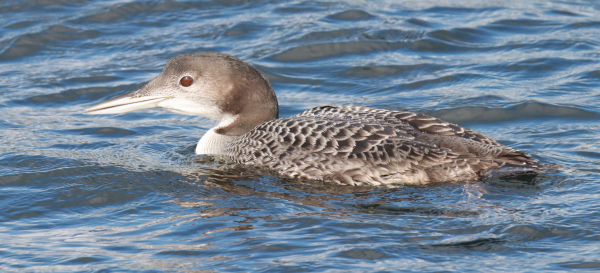
We were surprised by the high activity level of this 8-week old near-fledgling, as it was actively diving below the surface for extended periods, presumably to try to catch small fish. The first plumage of Common Loons is characterized by gray-brown dorsal feathers that have lighter colored scalloped edges (400mm zoom lens, f-10 aperture, 1/800 shutter speed, 800 ISO).
Not to worry, we no more than backed away from the dock when I saw an adult Common Loon in a little bay to the north, and a closer look with binoculars revealed a young loon. Unfortunately, the late afternoon turned cloudy on and off as individual clouds blotted out the sunlight, sometimes for extended periods, and this first cloud turned out to pose the longest wait for sunshine to resume. In the meantime, we had a chance to watch the loons from a distance, which revealed how active the fledgling was – dipping its head into the water to search for fish, diving for extended periods at times, stopping to preen time and time again, and rising up to flap its wings a couple times – all activities shared by the adult female that was showing the first signs of molting, with white feathers showing on its face, and molted feathers missing from its back and sides.
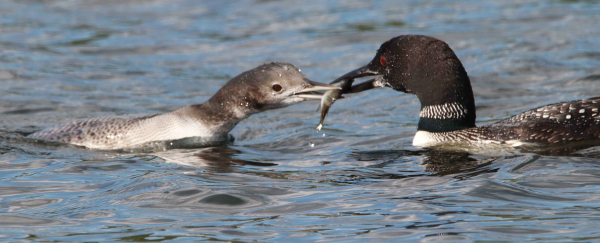
The adult Common Loon fed the near-fledgling 5 small fish during our photo period. Note the slight indication of molting feathers near the base of the adult’s beak (600mm zoom lens, f-10 aperture, 1/1250 shutter speed, 800 ISO).
We were surprised by how active the fledgling was, unlike others we have photographed at this stage of the season. The biggest cloud finally passed and Andy maneuvered the pontoon into position with the loons before us and the sun at our backs. I began photographing both loons, but concentrated on the young loon that was especially attractive and light-colored. Viewing its plumage at close range, it appeared to be fully molted into its first plumage, and when it flapped its wings we could see the flight feathers appeared to be fully developed. Was this loon flying, or trying to fly already?
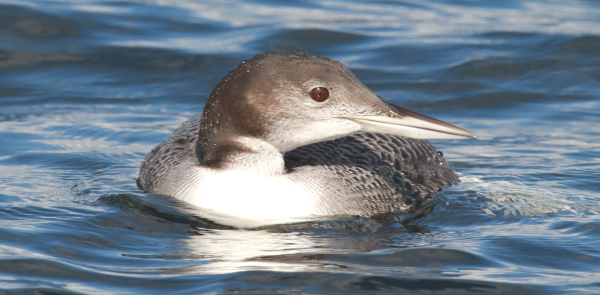
Although the young loon was actively fishing, we did not see it with prey, although it may have swallowed a fish before surfacing during sometimes long periods under water. Toward the end of our photo session, both loons spent an extended period close to the pontoon boat, as if they were showing more trust and a level of curiosity (550mm zoom lens, f-10 aperture, 1/1250 shutter speed, 800 ISO).
In our area we rarely see loons fly, so we didn’t expect to answer the flight question, but for our purposes, we referred to the young loon as a fledgling now. As soon as we began photographing the active young loon became even more active and both loons spent more time under water than above, which required Andy to reposition occasionally when the loons surfaced quite a distance away. We probably wouldn’t see the young loon swallow any fish it caught for itself, but we saw the adult feed the fledgling small fish at least 5 times. I tried to photograph the food exchanges, and managed to get a nice image of the fledgling receiving a small fish from the attentive female.
After a couple replays of passing clouds creating breaks in the photographic action, and a few repositioning efforts as the loons were actively hunting underwater, both loons suddenly appeared within 10 and 15 feet of the boat. I took a couple photos at the 600mm magnification, but quickly zoomed out to get better views of the birds’ actions and interactions. That’s when I managed to get my best photographs of the young loon in prime light and water colors. At that point, the fledgling seemed to take an interest in the floating silver ship, while the female seemed unconcerned, but maybe a little attracted too. When the young bird swam toward us, it provided a different view and photo op, showing a front profile for the first time.
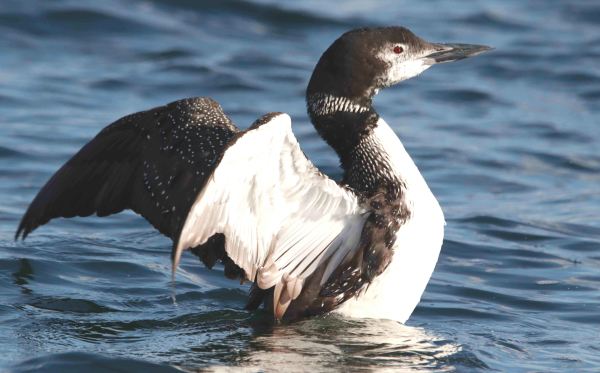
The first loon to show a more substantial amount of molting was an initial surprise, and it provided some added action to this photo as it raised up and flapped (450mm zoom lens, f-8 aperture, 1/2500 shutter speed, 800 ISO).
As the next cloud overwhelmed the scene, having already covered a lot of photo angles, Andy suggested that we check for loons on the big lake – Pelican Lake – which is attached to Little Pelican by a short stretch of river that connects the 2 lakes. This is really the first year that we have encountered family groups of loons on Pelican Lake, and the pairs we encountered in early June nested 3 or 4 weeks earlier than loons that nested at Little Pelican Lake. As a result we were interested to see what the fledgling loons on the big lake looked like now.
The Big Molt
Pelican Lake, however, had another plan for us. As it turned out, we wouldn’t find any family groups or young loons. Instead, we would encounter 6 adults in the form of 2 pairs and 2 single Common Loons. Starting with the first pair of adults, there was nothing out of the ordinary; both loons resembled the adult female on Little Pelican Lake with some early molting showing on their face near the beak and on their back. As I documented each of these loons, it became immediately obvious the lake was much more turbulent due to its much larger size, more open water space, and the stronger force of the wind, which made trying to focus on each loon harder. That made me reduce the aperture from f-10 to f-8 to increase the shutter speed to compensate for the added wave action on the water surface.
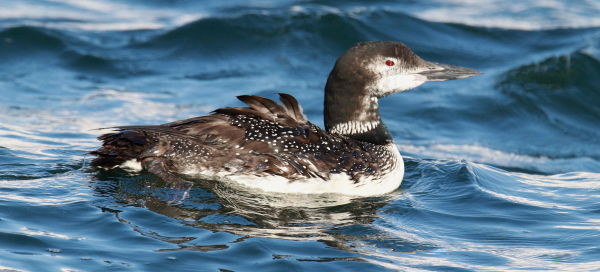
This photo of the same Common Loon shows a side view that reveals a better impression of the extent of molting on this lone adult. In the open water of the larger lake, the rougher wave action made it harder to steady the camera (450mm zoom lens, f-8 aperture, 1/1250 shutter speed, 800 ISO).
The next loon we found showed a much more advanced molt, with most of its facial plumage colored white, which extended down half of its neck; plus a considerable percentage of back and forewing feathers were already molted – quite a surprise! Still looking for a family group, next we found another molting adult that showed even more of a molting condition in the same areas of its body. The biggest difference was that its bill showed early signs of changing in color from black to a creamy gray.
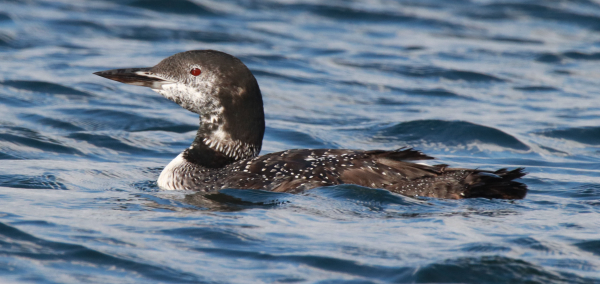
The next lone Common Loon showed a slightly more advanced molt with more of a color change on its beak (600mm zoom lens, f-8 aperture, 1/1600 shutter speed, 800 ISO).
The change in bill color was much more pronounced in one of the next adults we observed, as was the extent of the molt in a big way. One adult of that twosome looked like the loons I photographed in early October last year, but the other adult loon was still in the earliest stage of molt, resembling the female at Little Pelican Lake. I tried to get a photo with these 2 loons together, but it didn’t work out, although I did get good individual photos of them, concentrating more on the loon in the most advanced stage of molting.

Most surprising of all was this Common Loon that showed the most advanced molt, rivaling loons photographed in early October last year. This loon was with another adult that showed very little sign of molting aside from a few white feathers near its beak (600mm zoom lens, f-8 aperture, 1/1600 shutter speed, 800 ISO).
The loons we found on Pelican Lake actually showed 3 stages of molt from summer’s ‘alternate plumage’ to fall and winter’s ‘basic plumage.’ I share representative photos with you in the illustrations accompanying this article, along with the first 3 photos of the fledgling on Little Pelican Lake. As often happens on these loon pontoon photo cruises, there were surprises: First, the high activity level of the fledgling that was actively fishing, diving underwater often, sometimes for extended periods. Second, the varied levels of molting among the adult Common Loons was most unexpected. Photographing the loons really made the time spent on the water muy especial! And it underlined the fact that Andy and I learn more about these birds each time we embark on a loon photo outing. Plus, it seems I never get enough of studying these iconic birds – what fun we have each time we photograph under varied sunlight, weather, and water conditions!
Article and Photographs by Paul Konrad
Share your bird photos and birding experiences at editorstbw2@gmail.com